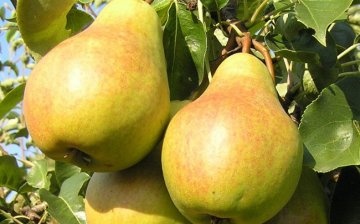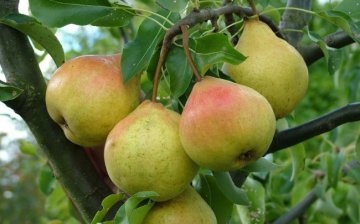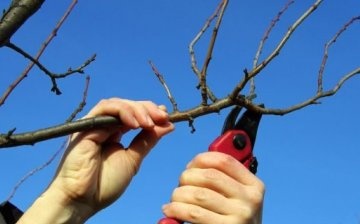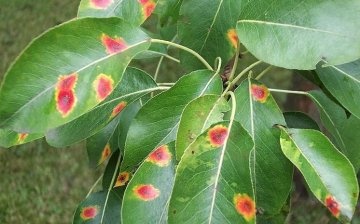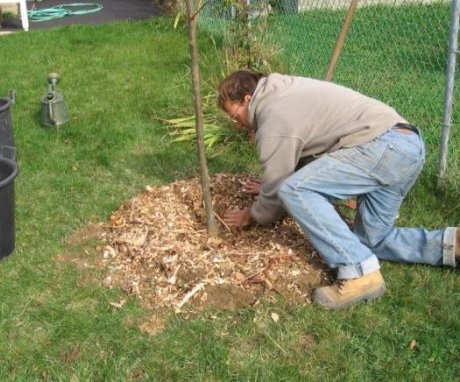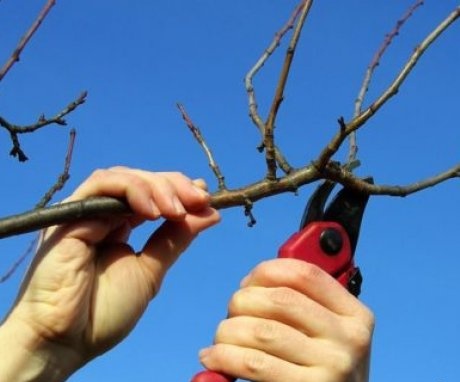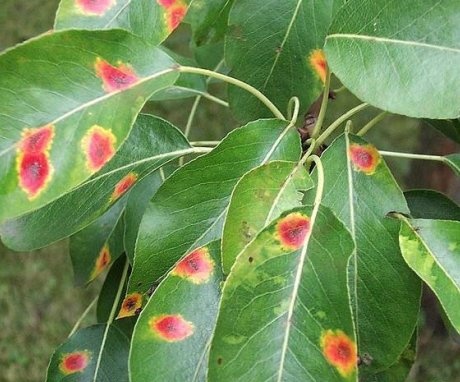Pear "Autumn sweet": description and cultivation
Industrial cultivation pears in our country it is developed only in the southern regions. However, amateur gardeners throughout Russia plant this crop on their plots and collect the fruits. The secret of a rich harvest is the choice of a variety, taking into account the climatic characteristics of the region and proper care.
Content:
Description and benefits of the variety
According to the ripening time, pear varieties are divided into summer, autumn and winter. Pear "Autumn sweet", as the name implies, refers to varieties that ripen in the fall, in late September - early October. Due to its high winter hardiness, it grows well in the Urals and Siberia, and has proven itself well in central Russia. In terms of taste, it is not inferior to southern varieties. Fruits are round, sweet, juicy, fragrant. The color is light yellow. The average fruit weight is 140 g.
The tree is medium spreading, the crown is rounded. The height of an adult pear depends on the rootstock. The yield is high. The undoubted advantage of the variety is its scab resistance. The variety is self-fertile; to obtain high yields, a pollinator is needed (the best is the Severyanka variety).
A pear is a more thermophilic tree than an apple tree, so when choosing a seedling, be guided by the seller's recommendations.
Usually, only zoned varieties adapted to local growing conditions are sold in nurseries. Let's consider the basic requirements:
- Temperature. Modern winter-hardy varieties can withstand cold temperatures down to -40 ° C (and some up to -56 ° C). However, in particularly harsh winters, as well as after thaws, flower buds and pear wood can be damaged. Flowers can withstand frosts up to -2оС, fruits - up to -4оС. At the same time, the heat resistance of the pear is weak.
- Light. The pear is light-requiring. When shaded in thickened plantings, it stretches. In the heat, the tops of young shoots can suffer from sunburn and dry out.
- Moisture. The tree belongs to moisture-loving crops. In the Urals and Siberia, in late spring (in May), natural precipitation is often not enough for the pear, so it needs to be watered. Young trees are especially sensitive to lack of moisture. Demanding water also depends on the stock.
- The soil. Grows well on loamy soils, chernozems. It is important that the soil is loose. Areas without a high groundwater table are preferred. Soil penetration depth root system pear depends on the rootstock and the growing region, however, the main part of the roots is usually found in the surface layer (50-60 cm).
Landing: timing and rules
For planting pears choose a place protected from drafts. Ideally - a warm slope or area next to the house on the south side. Lowlands, pits, where cold air stagnates, are completely unsuitable. When planting, calculate the future height of the tree and make sure that the grown pear does not shade other plants in the area.
Seedlings with an open root system are planted in autumn or spring.
Spring planting is recommended for regions with windy winters with little snow. In this case, the plants purchased in the fall are only added dropwise for the winter. Trees in containers can be planted all summer long. The landing pattern is 6x3 m or 5x4 m.
The sequence of the procedure:
- A landing hole with a diameter and depth of 60-70 cm is prepared in the fall.It is filled with humus (15-20 kg), 0.5 kg of superphosphate is added, mixed thoroughly and a mound is formed.
- Before planting, the seedling is taken out of the container and carefully examined root system... Damaged rotting roots are pruned to healthy tissue.
- The roots of the tree are dipped in a so-called "chatterbox" (a mixture of clay and water) for better contact with the soil.
- When planting, make sure that the root collar does not go below ground level. Taking into account the subsequent shrinkage, it can even be raised by 1-1.5 cm. However, if the planting is too high, the roots may be exposed in the future. This should not be allowed.
- The roots of the seedling are gently straightened.
- When filling the planting hole with earth, it is slightly compacted (trampled).
- After planting, the tree is watered abundantly until the water goes well into the ground, and mulch.
- If the root system is severely pruned, the shoots of the seedling are shortened by one third to bring the above-ground part of the plant in line with the underground one.
In the first few weeks after planting, provide the tree with abundant watering.
Care Tips
How to properly care for a tree:
- Fertilizer. Trees have the ability to store minerals from fertilizers. To form 1 ton of pear harvest, on average, 1.53 kg of nitrogen, 0.37 kg of phosphorus and 1.72 kg of potassium are required. Organic in the fall in the trunk circles when digging once every 3 years at the rate of 3-5 kg compost or humus per 1 sq.m. Nitrogen is fertilized annually (in spring) at the rate of 20-30 g of ammonium nitrate per 1 sq. M. Phosphorus and potash fertilizers are applied in the fall. This increases the winter hardiness of trees, especially young seedlings. The first 3-4 years after planting, fertilizer is not applied.
- Watering... In dry summers without precipitation, the tree must be watered. A special need for moisture in pears is observed during the period of growth (June) and pouring of fruits (August). It is watered so that the moisture moistens the soil layer by 50-70 cm. To preserve moisture, the trunks are mulched with peat, humus or other loose material. Before wintering, if the autumn is dry, water-charging watering is carried out. The best time for this is autumn leaf fall, before the onset of the first frost.
- Cleaning and whitewashing. In the fall, all fallen fruits and leaves are removed and destroyed in order to prevent the spread of diseases. Tree trunks are cleaned of peeling bark and whitewashed. This protects the plant from sunburn and frost damage. The soil in the near-trunk circles of young trees is cleared of vegetation until mid-summer, and then green manure crops are sown. In the fall, they are mown and buried in the ground. This procedure has a double benefit: as the green manures grow, they take excess nitrogen from the soil, and after embedding in the ground, they decompose and give the tree nutrients in the spring.
- Pruning... The crown of a pear thickens strongly after winter damage, so it needs to be thinned out. Sanitary pruning is carried out annually: tops growing inside the crown are removed. In the spring, branches that have not survived the winter are removed. If only the upper wood is frozen underneath (inside the center of the branch is green), such shoots are preserved, shortened by one third. When removing branches, pruning is carried out "on the ring", leaving no stumps.
- Acceleration of the harvest and graft... Typically, a pear harvest can be expected 6-8 years after planting. It can be accelerated by grafting a cutting onto a fruiting tree. Choosing the right stock will increase the hardiness and vitality of the pear. Amateur gardeners graft on quince and hawthorn (in central Russia), irga and chokeberry (in Siberia and the Urals). The inoculation is carried out at a height of 50 cm from the ground by budding. The best time is from the second decade of July to mid-August. As a result of vaccination, the expectation of the harvest can be reduced to 4-5 years.
Diseases and pests
Of the pests on the pear there are:
- The leafworm is a butterfly that damages many fruit trees (apple tree, plum, cherry, apricot and others) and forest species.The pest lays eggs on the leaves, from which caterpillars then appear. They glue the leaves together with a cobweb or with fruits. Damaged leaves dry up, and the fruits are deformed. As measures to combat the pest, spraying with biological insecticides or chemical preparations is used.
- Aphid feeds on the cell sap of the leaves, and also promotes the spread of the sooty fungus. The fight is carried out with folk remedies (washing with soapy water, spraying with herbal or garlic infusion) and special preparations.
- The pear moth is a butterfly that damages only the pear. Early varieties are most harmful. The female lays eggs on the fruit. The emerging caterpillars penetrate and eat the seeds. Distributed only in warm climates (in the Caucasus, Europe and Syria).
Diseases in a pear are the same as in other fruit:
- With fruit rot, brown spots are formed, which then grow and occupy the entire surface of the fruit. Damaged fruits are removed, fallen fruits are collected and destroyed. The tree is sprayed with copper-containing preparations (bordeaux liquid).
- Scab develops on all parts of the plant: flowers, shoots, leaves and fruits. It manifests itself as dark growing spots. Fruits on affected trees are small and few in number. Control measures are the same as for fruit rot.
- With rust, the leaves are covered with bright orange spots, on which pathogenic fungi develop - the causative agents of the disease. Control measures are similar to those described above.
As a preventive measure, in the fall, after leaf fall, trees are sprayed with 5% copper sulfate (300 g per bucket of water). First, it is diluted in a liter of hot water, and then mixed with the rest of the volume. This is called eradication treatment. In the spring, trees are sprayed with a 3% solution of Bordeaux liquid and karbofos.
Thus, pear cultivation is not fundamentally different from caring for other fruit trees. Half of the success is choosing the right planting material, adapted to the specific location. Do not purchase seedlings from unknown vendors. Choose time-tested varieties, for example, "Autumn Sweet".
More information can be found in the video:



